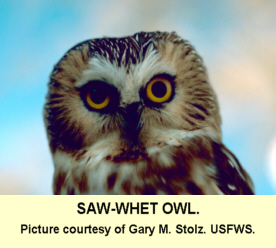
SAW-WHET OWL.
Aegolius acadius
IDENTIFICATION. The Latin word "acadius" refers to the territory where this owl was first discovered. The North American colony called Acadia (now Nova Scotia). Divided into 2 subspecies, Aegolius acadius acadius Northern Saw-whet Owl and Aegolius acadius brooksi the Queen Charlotte Island Saw-whet.
A short bodied owl with a large head. The facial disk is a mixture of greys, buffs and browns with a white feather V between the eyes leading to a white streaked black crown. The eyes are large and yellow set above a black beak. Plumage is brown to reddish brown with a spotted back and white streaking underneath. The legs and feet are feathered and light buff in colour.
May be mistaken for the related Boreal owl, Aegolius funereus.
IN FLIGHT. In flight appear larger because of their broad wings.
DISTRIBUTION. Aegolius acadius acadius is the race from Canada, Western American and North mexico. Aegolius acadius brooksi is found on Queen Charlotte island. Saw-whet prefer dense coniferous and deciduous woodland that is damp or swampy.
FOOD. Generally small mammals, including bats, birds, amphibians and insects.
BREEDING. March-April. 4 to 7 eggs laid in tree hole . Young hatch after 27 days incubation. Fledging takes place 4-5 weeks later.
SIZE. 18-20cm (7-8in)
WEIGHT. 75-110g (2.6-3.9oz)
WINGSPAN. 43-52cm (17-20in)
CALL. 'toot toot toot' or an alarmed skiew'
FALCONRY.
Not generally used in falconry due to its small size.
Falconry marks
![]()